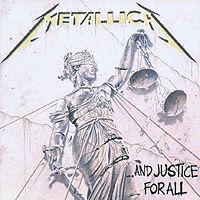It's been exactly 20 years since Metallica released their highly acclaimed fourth album, ...And Justice for All, which could have been an absolute killer. Not only was it the followup to their 1986 classic, Master of Puppets, but it was also the first album recorded with new bassist Jason Newsted, replacing the late Cliff Burton. I remember waiting very patiently for this record to come out, and saving the last of the money I had on me so I could buy it. I finally bought it sometime back in the fall of 1988 along with the Suicidal Tendencies record, How Will I Laugh Tomorrow, and I was hooked when I listened to it for the first time.
The death of bassist Cliff Burton was definitely a blow to Metallica, and likely affected the writing process of their next album. But they survived the ordeal and in 1988, looked to release â¦And Justice for All. Predictably, the album had nothing on their previous works. Though by no means a terrible offering, Metallica's fourth album is quite unlike both Ride the Lightning and Master of Puppets, as it is a difficult album to both get into and enjoy.
Justice contains Metallica's most sophisticated, heaviest riffs yet. A lot of changing tempos, a lot of weird rhythms, a lot of palm-muted guitars and a lot of excellent solos courtesy of one Kirk Hammett, specifically "One," "Blackened" and "Dyers Eve." What 's interesting about this record is how most of its solos are actually divided in two, with a small break in between. A pure example of that is opener "Blackened." The solo comes in after an impressive guitar harmony and at first, it's pretty measured. The riff in the background isn't the thrashy riff that's so characteristic of the song but a very heavy one, and the solo builds on it very well, only getting faster and faster until finally making a screeching halt, giving way to Hetfield's powerful rhythm guitar to show its face one more time before Hammett finally goes berserk and bombards us with perfectly placed, lightning-fast notes backed by fast riffing and drumming, eventually throwing the song's trademark riff right back at your face for the final blow. Justice is filled to the top with moments like this of songs building up, just like a hammer being swung backwards before it's flung forward to crush the rock below it. The drumming on Justice is also very good and definitely showcases Lars Ulrich's best, most inspired work, specifically on the title song.
Justice also includes an instrumental piece called "To Live Is to Die." This instrumental, unlike the mysterious "Orion," is very sad and desperate, though it does have a very similar structure: heavy guitars, a solo, a soft bridge and finally back to the heavy for one more moment of power and a fade-out ending. Worthy of special mention is the melodic section in the middle of the song. This depressing riff is divine on its own, but when it gets the company of James and Kirk's guitars it becomes the most powerful moment on the album. The ending of the instrumental, based around a poem written by the late Cliff Burton, only gives the piece more power and keeps making me feel bad that it actually ends with these lyrics:
When a man lies"One" may actually be the most overrated song here, with the highlights including "Blackened," "...And Justice for All," "Harvester of Sorrow," "Frayed Ends of Sanity" and "Dyer's Eve" -- all very good thrash-metal songs.
He murders some part of the world
These are the pale deaths
Which men miscall their lives
All this I cannot bear to witness any longer
Cannot the kingdom of salvation take me home?
Bottom line: I recommend you buy your own copy of ...And Justice for All, if you don't own it. Check it out. Buy it. Listen to it. Whatever.
